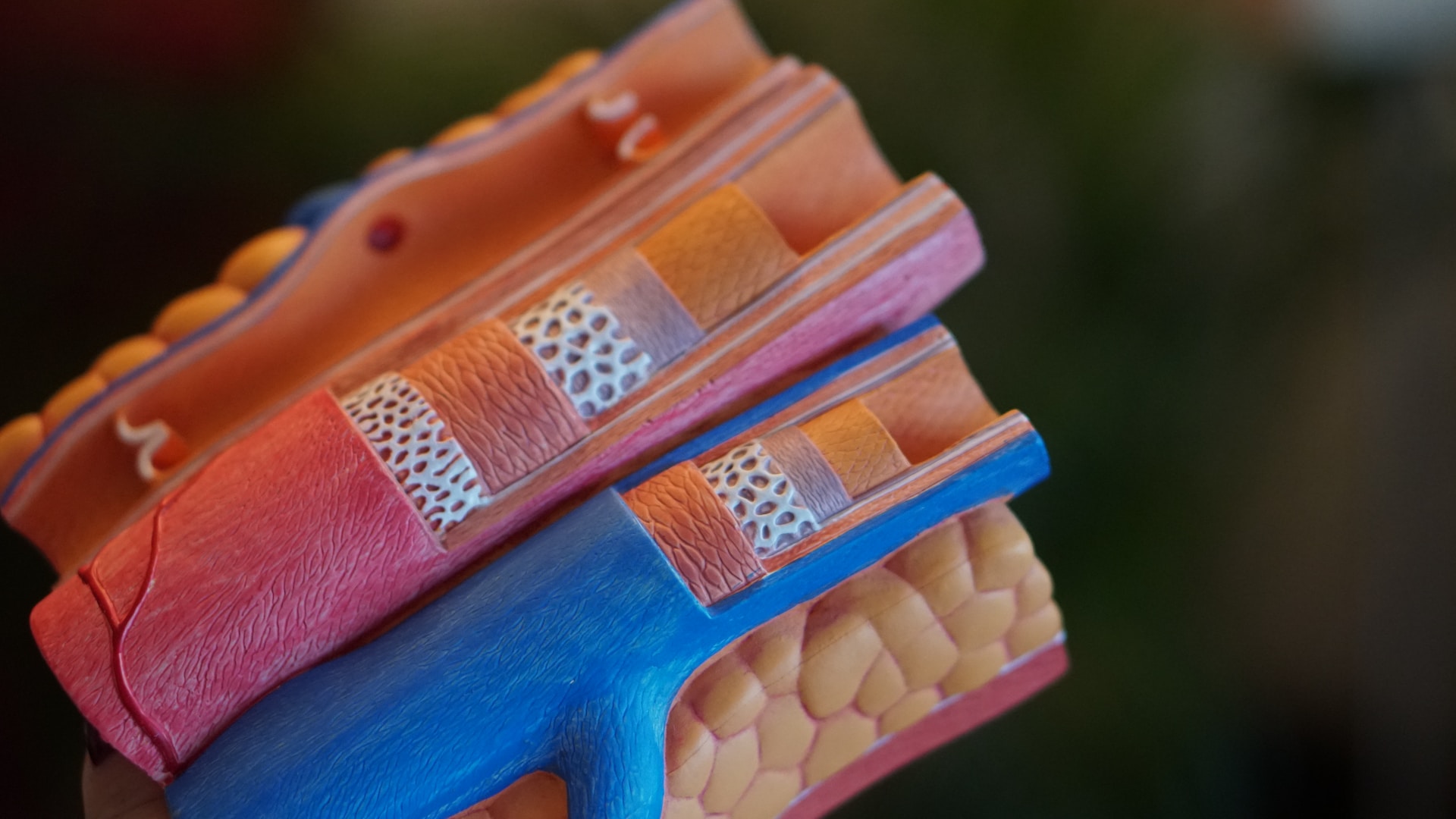The radial artery is one of the main arteries that supply blood to the forearm and hand. It originates from the brachial artery, which is a continuation of the axillary artery from the shoulder. The radial artery runs along the lateral (thumb) side of the forearm, then curves around the wrist and enters the palm. Along its course, it gives off many branches that nourish the muscles, bones, joints, nerves, and skin of the forearm and hand.
Anatomy of the Radial Artery
The radial artery can be divided into three segments:
- Forearm
- Wrist
- Hand
Forearm
The radial artery begins at the elbow, where it branches off from the brachial artery. It crosses the elbow joint and travels along the medial (inner) side of the radius bone. It lies deep in the brachioradialis muscle in the upper part of the forearm and between the tendons of the brachioradialis and flexor carpi radialis muscles in the lower part.
In the forearm, the radial artery gives off several muscular branches that supply blood to the muscles of the lateral (outer) part of the forearm, especially the extensor muscles that straighten the wrist and fingers. It also gives off a radial recurrent branch that ascends to join with the radial collateral branch of the brachial artery, forming an anastomosis (connection) around the elbow joint. This provides an alternative route for blood flow in case of injury or obstruction of either artery.
Another branch of the radial artery in the forearm is the palmar carpal branch, which runs along the anterior (front) side of the wrist and joins with a similar branch from the ulnar artery, forming the palmar carpal arch. These arches supply blood to some of the structures on the palmar side of the wrist and hand.
Wrist
The radial artery reaches the wrist and passes around its lateral (outer) side, crossing over a depression called the anatomical snuffbox. This is a triangular-shaped area on the back of the hand, bounded by the tendons of two thumb muscles (extensor pollicis longus and brevis) and a wrist muscle (extensor pollicis radialis). The radial artery can be felt as a pulse in this area.
At the wrist, the radial artery gives off two branches:
- A dorsal carpal branch
- A first dorsal metacarpal branch
The dorsal carpal branch runs along the posterior (back) side of the wrist and joins with a similar branch from the ulnar artery, forming the dorsal carpal arch. These arches supply blood to some of the structures on the dorsal side of the wrist and hand. The first dorsal metacarpal branch splits into two smaller branches that supply blood to the adjacent sides of the thumb and index finger.
Hand
The radial artery continues from the wrist to the palm, passing between the two heads of the adductor pollicis muscle, which pulls the thumb towards the palm. It then gives off two important branches:
- The princeps pollicis artery
- The radialis indicis artery
The Princeps pollicis artery runs along the lateral (outer) side of the thumb and divides into two digital branches that supply blood to the front and back surfaces of the thumb. The radialis indicis artery runs along the medial (inner) side of the index finger and supplies blood to its front and back surfaces.
The Princeps pollicis and radialis indicis arteries may sometimes arise from a common trunk called the first palmar metacarpal artery.
The radial artery then curves medially (towards the middle) and joins with the deep branch of the ulnar artery, forming the deep palmar arch. This arch gives off three palmar metacarpal arteries that run along the palm and divide into four common palmar digital arteries. These arteries further split into eight proper palmar digital arteries that supply blood to the front surfaces of the fingers (except for the thumb and index finger).
Function of the Radial Artery
The radial artery is responsible for delivering oxygen-rich blood to the forearm and hand, which are vital for performing various functions such as grasping, manipulating, writing, typing, etc. The radial artery also helps regulate the temperature of the hand by dilating or constricting according to the environmental conditions or body needs.
The radial artery is also important clinically, as it can be used to measure the heart rate by feeling the pulse at the wrist or the anatomical snuffbox. It can also be used as a site for blood sampling, blood pressure measurement, or catheter insertion for various diagnostic or therapeutic procedures. However, these procedures may carry some risks such as bleeding, infection, nerve damage, or reduced blood flow to the hand.
Latest Trends and Updates on the Radial Artery
The radial artery has been increasingly used as a source of grafts for coronary artery bypass surgery (CABG), which is a procedure that restores blood flow to the heart muscle when the coronary arteries are blocked by plaque. The radial artery is preferred over other grafts such as the saphenous vein or the internal mammary artery because it has better long-term patency (staying open) and lower rates of complications such as infection or thrombosis (clotting).
However, using the radial artery as a graft may also have some drawbacks, such as reducing blood flow to the hand or causing hand pain or numbness. Therefore, before harvesting the radial artery, a test called Allen’s test is performed to assess the adequacy of blood supply to the hand by the ulnar artery. If the ulnar artery is sufficient, then the radial artery can be safely used as a graft. If not, then another graft source should be considered.
Another recent trend involving the radial artery is its use as an access route for percutaneous coronary intervention (PCI), which is a procedure that opens up blocked coronary arteries by inserting a balloon or a stent through a catheter. Traditionally, PCI was performed through the femoral artery in the groin, but this approach has some disadvantages such as bleeding, infection, or vascular complications. The radial artery offers a safer and more comfortable alternative, as it has lower rates of bleeding and complications, faster recovery time, and better patient satisfaction.
However, using the radial artery for PCI also requires more skill and experience from the operator, as it has a smaller diameter and more tortuosity (curves) than the femoral artery. It also poses some challenges such as difficulty in crossing the aortic arch or the coronary ostia (openings), spasm or occlusion of the radial artery, or reduced blood flow to the hand. Therefore, careful patient selection and operator training are essential for successful radial artery PCI.
How the Radial Artery Revolutionized Peripheral Artery Disease
Peripheral artery disease (PAD) is a common condition in which narrowed arteries reduce blood flow to the arms or legs. The most common type is lower-extremity PAD, in which blood flow to the legs and feet is reduced. PAD is a form of atherosclerosis, the buildup of fatty deposits and other substances in the arteries. PAD can cause leg pain when walking (claudication) and other symptoms.
Traditionally, PAD interventions were performed through the femoral artery, which is the main artery in the groin, but this approach had some drawbacks such as bleeding, infection, or vascular complications. The radial artery offered a new option for treating PAD in certain peripheral vascular beds, such as cerebrovascular, mesenteric, renal, lower extremity, and upper extremity.
The advantages of using the radial artery for PAD interventions include lower risks of access site complications, faster patient recovery time, lower healthcare costs, and higher patient satisfaction. With ongoing innovation and studies demonstrating the effectiveness and safety of this approach, “radial first” for peripheral interventions has a bright future and may someday become the standard of care for certain peripheral interventions.
Conclusion
The radial artery is a major vessel that supplies blood to the forearm and hand. It has a complex anatomy with many branches and anastomoses that ensure adequate blood flow to the structures of the forearm and hand. It also has important clinical applications such as measuring the heart rate, performing blood tests or interventions, or providing grafts for bypass surgery. However, these applications may also involve some risks or challenges that require proper evaluation and management. The radial artery is a vital vessel that deserves attention and care from both patients and physicians.





